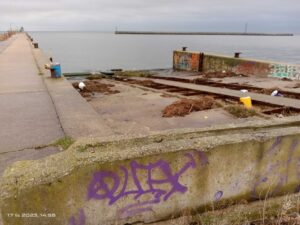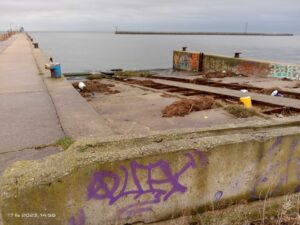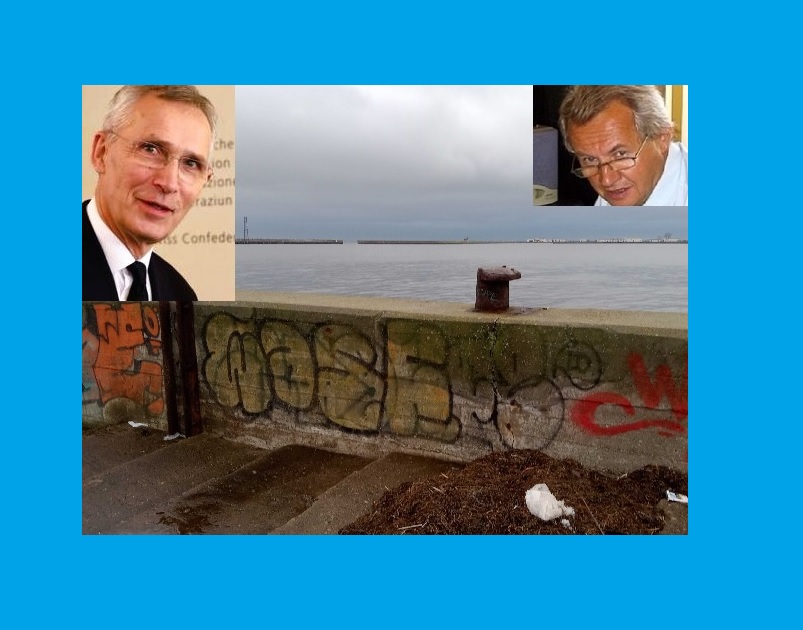„Szanowny Panie Sekretarzu Generalny,

(…) Hel, ale i cały półwysep to cudo natury – długi na 36 km, wąski pasek lądu miedzy morzem a Zatoką Gdańską. To skarb Polski tak jak Tatry, Mazury, Karkonosze.
O Hel biliśmy się od wieków – ze Szwedami, w 39 bohatersko broniono go przez 32 dni, pod koniec wojny wywożono stąd Kaszubów morzem do Niemiec, a po wojnie w stalinowskich więzieniach zgładzono najdzielniejszych obrońców. Trzeba o tym pamiętać.
Baza ludzi bezradnych
Są wspomnienia. W latach 1932-1935 Polacy zbudowali na Helu ważny port wojenny. Otoczony falochronami. Na zatoce ale z głębokim dojściem od morza. Stanowił ważną bazę marynarki wojennej. Stąd jest tylko mały skok na Bałtyk. Każdy kraj marzy o takim porcie obronnym. Tylko nie u nas.
U nas od prawie 80 lat świetnie zlokalizowany port wojenny na Helu to akwen pusty, szczyt marnotrawstwa – zniszczone falochrony, zniszczone pochylnie slipowe, drogi dojazdowe. Syf i śmietnisko. Choć jest większy od sąsiedniego portu rybackiego i żeglarskiego pozostaje niewykorzystany, zbędny.
Agencja Mienia Wojskowego – dysponent, wydzierżawiła ostatnio połowę portu, kilkadziesiąt metrów długości i szerokości – Uniwersytetowi Gdańskiemu. Przerwało to wprawdzie postępującą dewastację – wyrywanie kabli i złomu. Ale nic poza tym. Niestety może być jeszcze gorzej jeśli UG wykona tu jakieś inwestycje na wodzie. Na przykład zbuduje klatki hodowlane podobne do pobliskiego fokarium, które zatruwa zatokę odchodami zwierzęcymi i zarazkami. Larwy nicienia hodowane we wnętrzach fok to zaraza dla ryb i ludzi (a kąpią się tu latem). Rozbudowa pustego obecnie basenu przez pomysły naukowców z Politechniki Gdańskiej może zniweczyć wykorzystywanie później portu jako akwenu wypadowego dla floty nawodnej i podwodnej.
Szczury uciekają z tonącego okrętu. Z portu wojennego na Helu nie bardzo mają gdzie uciekać, ponieważ zburzono tu w ciągu ostatniego roku dziesiątki budynków lądowych zaplecza wojskowego. Co tu w końcu będzie, jakie będą decyzje na najwyższych szczeblach wojskowej władzy i państwa – nie wiadomo. Sądząc po ogłoszeniach przetargowych w gazetach ilość sprzedawanych obiektów wojskowych w całym kraju jest bardzo duża. Na Helu pozostaje zdawałoby się drogocenna ale pusta przestrzeń. W prywatnych rękach zniknęło już wielkie wojskowe kasyno, bardzo ładne kino. Żołnierzy, marynarzy już tu na ulicach nie widać.

Port wojenny to ostatni bastion morskiej wojskowej obecności na Helu. Idę falochronem do główki potężnego betonowego obiektu wychodzącego w wody zatoki. Jeszcze są polery służące do cumowania wielkich nawet jednostek. Złomiarze ich nie ukradli, bo są mocno osadzone i ważą tony. Hula wiatr i chłoszcze bryza. Ale jest tu pięknie.
Raz do roku, w sierpniu, dla wczasowiczów i turystów odbywa się tu wojskowa zabawa imitująca lądowanie aliantów w Normandii. Zjeżdżają się wówczas z całej Europy zabytkowe samochodziki wojskowe a nawet czołgi i działa. W mundurach z tamtych lat paradują kombatanci i miłośnicy militariów, przebierańcy. Na pewno przyciąga to młodzież do wojskowej służby. Ale tylko przez kilka dni. Bo tyle trwa kolorowa impreza. Wtedy port wojenny również ożywa. Ale potem nadal gnije.
„…będziem strzec”
Ładnie o morzu mówimy w wierszykach i piosenkach. „… będziem strzec”, a nawet deklarujemy, że może i przyjdzie „na dnie lec”. Ale przecież my floty z prawdziwego zdarzenia nie mamy. A podwodnych okrętów – aż dwa. Tylko nędzne resztki, starocie. Mamy oczywiście wielu generałów i admirałów w służbie i na emeryturze.
Kilka lat temu rozmawiałem z cywilnym wodzem armijnym. Na pytanie o planu rozwoju floty wojennej, o okręty podwodne, usłyszałem: „A po co, przecież są rakiety – na Bałtyk wystarczą”. I tak zostaliśmy z 40-letnim, po pożarze, okrętem podwodnym i 50-letnim „kieszonkowym” podarowanym łaskawie. Przerabialiśmy też kuriozalny incydent, gdy Dowództwo Marynarki Wojennej przeniesiono z Gdyni do Warszawy. Na szczęście trwało to krótko, ktoś puknął się w głowę. Choć można było to dowództwo umieścić nad Morskim Okiem.
Dramaty stoczniowców, unicestwienie przemysłu okrętowego dopełniają obrazu. „Morze, nasze morze, wiernie ciebie będziem strzec”. Ciekawe czym. Józef Unrug, Włodzimierz Steyr – przewracają się w grobie. Niedawno dowiedzieliśmy się jak miała wyglądać obrona kraju na lądzie, na linii Wisły. Jak to by miało przebiegać na morzu. Tajemnica wojskowa.
***
Please find attached my piece on the Polish naval base in Hel and the its wasted potential. In the light of Sweden’s forthcoming NATO membership, the military port in Hel – together with Swedish navy bases in Musko and Karlskrona -could greatly boost NATO ability to project naval power in the Baltic Sea. I believe you will find my text interesting.
HEL IS NEAR, YET SO FAR AWAY
by Stefan Truszczyński

Photo: Stefan Truszczyński
Time flies. I last saw the former military grounds in Hel exactly one year ago.
After the armed forces left, these eighty hectares in prime location have lain abandoned. Now I have returned to look and see what has been done since my last visit.
Hardly anything. The local authorities seem unable to do anything on their own.
The entire 36-kilometre long peninsula with the town of Hel at its wide tip is a true wonder
of nature. Wedged between the open sea and the Gulf of Gdansk, it is one of Poland’s most outstanding natural treasures whose natural beauty rivals that of the Tatra Mountains or the Masurian Lake District.
Poland fought over this piece of coast against various enemies throughout its history.
At the outbreak of World War 2, outnumbered Polish defenders held their ground for 32 days and Hel was among the last Polish outposts to surrender. The people of Kashubian ethnicity who had lived here for centuries were deported to Germany towards the end of the war.
The last surviving defenders perished in Stalinist prisons after the war. Thinking about Hel,
we must remember what price many Poles paid to keep the peninsula Polish.
Deserted base
Poland regained independence after World War 1 and quickly understood the importance
of having a strong navy. For that reason, we soon built a modern military port near the town of Hel. Surrounded by breakwaters, it faced the Gulf but had a deep water access to the open sea.
It was protected from the north and east by a wide strip of land but at the same time offered a quick route to the Baltic Sea. Many countries can only dream of such a prime location for their naval base. But despite these advantages, since the 1980s the military port has been falling into disrepair and finally became a shadow of its former self: empty docks, crumbling breakwaters, neglected slips and unused roads full of potholes. Total mess and heaps of rubbish. Much larger than the nearby fishing and yacht harbour, Poland’s first modern naval port remains deserted.
The Military Property Agency has recently leased half of the naval base to the University of Gdansk. That move put a halt to the ongoing devastation, destruction and theft, however, it may turn out even worse if the university installs seal breeding cages in the docks, like in the nearby seal sanctuary. Faeces and germs from these animals pose a serious risk to both fish and people. Furthermore, civil engineering projects altering the docks could make any future military use of the port facilities impossible.
Numerous base buildings and structures have been demolished over the past year.
Nobody knows what decisions might be taken at the highest levels of military command and civilian administration. Former military facilities are sold at auctions all over Poland.
In Hel, the military base area still awaits its fate. A large navy casino and a beautiful cinema building have already changed hands. Military personnel and navy sailors who used to be common view in the streets of the town are nowhere to be seen.

Photo: Stefan Truszczyński
The former military port is the last remnant of the Polish naval presence on the peninsula.
I walk along the breakwater protruding into the waters of the Gulf. Heavy bollards designed for mooring large vessels are still there: firmly fixed to the concrete, they have resisted scrap metal thieves who have robbed the entire area of anything of value.
Amazingly, hundreds of uniformed soldiers populate this area every August. Military vehicles fill the streets, trucks pull cannons, tanks roll along local dirt roads. But do not be mistaken.
It is only a re-enactment of the Allied Forces’ landing in Normandy – an annual performance for tourists. Historic military equipment arrives from all over Europe. Veterans and enthusiasts parade in WW2 uniforms. Then the participants and spectators leave and the eerily empty base continues to rot away.
How to guard “our sea”?
Polish youth pledge allegiance to the Baltic Sea by singing a popular song, whose lyrics include the vows to “guard our sea” and to “keep it or die and rest on its bottom”. In reality, Poland has little to defend its sea with. Polish navy has merely two old, battered submarines – miserable remnants of better times. By contrast, we have an awful lot of admirals, serving and retired.
A few years ago I talked to a civilian head of the Polish military and I asked about Poland’s plans for the navy, specifically regarding new submarines. “What do we need them for?”
he replied, “Missiles are enough for the Baltic Sea”. And now we are left with one 40-year-old submarine salvaged from a fire on board and a 50-year-old 'pocket’ submarine donated to us by another country. Ironically, the Germans who used the navy port in Hel during World War 2 kept there more submarines than all Polish navy has today.
Experienced shipbuilders lost their jobs, shipyards disappeared, the shipbuilding industry has been annihilated. The Poles may sing “Oh, our sea, we will guard you faithfully”, but the most solemn vows cannot make up for tangible military hardware. Józef Unrug and Włodzimierz Steyr, great Polish admirals of the past, are turning over in their graves. The public was recently shocked by the leaked information that if attacked from the east, Poland would keep its defence line not along its border… but along the Vistula River. Nobody knows the plans for the sea. Military secret.
Derelict factories
The tip of the Hel Peninsula is a unique piece of Poland. There are forests, beaches and quays. Thousands of holiday makers come to the town of Hel in summer. And what do they see?
Sad relics of once-thriving fish industry which used to process over 50 thousand tonnes of fish per year. The factories fell into disrepair, they have been reduced to windowless, dilapidated shells, which look haunted. Some were sold. Fortunately the land on which they stand is still owned by the state. The fish caught every day are exported and Hel gets nothing. Local residents lost their jobs and most of them have left. Nobody knows what will happen to the ruins.
Most people have got used to this depressing sight. It is what it is. An eyesore and a sad reminder of many wasted opportunities.
Beach, bunkers and trenches
An efficient transport system between the town centre and the seashore is urgently needed.
The Baltic beach is exceptionally beautiful here, wide, sandy… and almost empty in summer. At the same time thousands of holidaymakers are crammed and squashed on a stretch of dirty sand between the fishing harbour and the military port on the Gulf side of the peninsula.
Three or four kilometres of narrow-gauge rail through the forest would solve this problem and turn the Hel area into a summer destination attracting tourists from all over Europe.
The sandy dunes hide other unknown attractions. A historic, post-war, coastal defence line consisting of bunkers, artillery aiming towers and kilometres of trenches. A disused, crumbling navigation signal tower on the Mount of Swedes – a kind of lighthouse erected almost one hundred years ago, which needs some repair to become a popular tourist attraction.
And a huge bunker in the forest not far from the town centre, which could easily be one of Hel’s highlights but is used as a toilet instead.
Who’s in charge?
A year ago, I pointed out that the town had zero filling stations. Prominent people promised to help but eventually did nothing. After the last general elections, the priorities have changed and all VIPs have forgotten about local drivers. A year ago, I wrote about trees standing dangerously close to the main road of the peninsula. Some trunks still bear marks of vehicles: sad reminders of fatal accidents. Hundreds of trees in the nearby forest are cut down but those which pose real danger are left intact. Should it not be the other way round? How many more people must die before something changes?
There are three towns of the peninsula: Władysławowo, where the peninsula connects with the mainland, Jastarnia in the middle and Hel on the far end. Of those three only Jastarnia has made some progress. The town renovated the fishing and yacht harbour and built a winter marina.
It paid off. Good town management attracted investors and money poured in. But only so much can be done locally. Without the central government’s plan for the coast, the town of Hel and the entire peninsula will never fulfil its true potential.
Hel may be located on the far the edge of Poland, but for the decision makers it seems to be somewhere beyond the horizon. Hel will never cope on its own. When will the politicians finally understand it?

